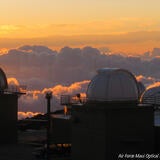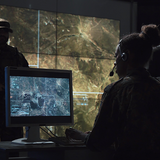A Record of Optical Excellence: Past, Present and Future
Our high-performance optical components and assemblies have been integral to the world’s most sophisticated ground and space-based telescopes and satellites for more than 50 years.
Take the U.S. Space Force’s network of Ground-Based Electro-Optical Deep Space Surveillance System (GEODSS) telescopes for example, which is a vital part of the SSN.
This optical space surveillance system can track objects as small as a basketball more than 20,000 miles away. As a result, it’s used to search for, detect, track, identify and report on all deep-space objects.
Most importantly, this system provides mission-critical space surveillance information to the Combined Space Operations Center (CSpOC) and the Distributed Space Command and Control – Dahlgren (DSC2-D), whose mission is to ensure the nation’s combined space enterprise meets and outpaces emerging and advancing space threats.
L3Harris was the original equipment manufacturer for the GEODSS optical tube assembly and mount. Now, we’re helping the U.S. Space Force upgrade and expand this critical network of GEODSS telescopes.
Our experience across the range of optical material systems enables us to balance performance with affordability for any given mission. We’ve also leveraged our extensive array of space-domain-awareness system knowledge and expertise to develop a family of cutting-edge gimbaled EO payloads for space-based space domain awareness.
L3Harris is ensuring the nation remains dominant in the space domain through programs that enhance the U.S. military’s ability to track and respond to anti-satellite threats, including:
- Maintenance of Space Situational Awareness Integrated Capabilities (MOSSAIC)
- Advanced Tracking & Launch Analysis System (ATLAS)
- Space Development Agency (SDA) Tracking Layer
- Missile Defense Agency (MDA) Hypersonic and Ballistic Space Sensor (HBTSS)
But our offerings and expertise don’t end at space domain awareness.










